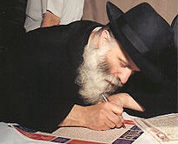 Rabbi Avrohom Blumenkrantz
Rabbi Avrohom Blumenkrantz
1944 – 2007
Rabbi Avrohom Blumenkrantz was a prominent American Orthodox rabbi. He was a widely consulted authority on the laws of Passover kashrut and published an annual Passover guide for many years.
Rabbi Blumenkrantz was born in Mandatory Palestine to parents of Ashkenazi European extraction, Rabbi Chaim Menachem Bentzion and Rebbetzin Devorah. His father was a highly trained talmudic scholar from Warsaw, who attended some of the best yeshivas in pre-war Europe, including the Novardok yeshiva. In 1948 Rabbi Chaim was abroad at the outbreak of the War of Independence, and chose not to return. Instead young Avrohom and the rest of the family left Israel aboard a ship. In the early 1950s the family settled in Bogotá, Colombia, where Rabbi Chaim became chief rabbi.
Avrohom began his education in Bogotá, but came to New York City as a teenager to study at Mesivtha Tifereth Jerusalem under the famed Rabbi Moshe Feinstein, with whom Rabbi Blumenkrantz maintained a close relationship until Rabbi Feinstein’s death in 1986.
Rabbi Blumenkrantz became a confidant of Rabbi Feinstein, screening his calls and filtering the constant stream of halakhic questions posed to the posek. At age 25 Rabbi Feinstein asked his student to teach a semicha class in Yoreh De’ah at MTJ. Afterwards, Rabbi Feinstein directed his student to prominent teaching positions in Staten Island and then Brooklyn, at which Rabbi Blumenkrantz excelled.
Following in his father’s footsteps, Rabbi Blumenkrantz took the helm of a synagogue in Far Rockaway, Queens.
Aside from being a teacher and a community rabbi, Rabbi Blumenkrantz is best remembered for his annual Passover guide, The Laws of Pesach, a publication relied on by observant Jews throughout North America to maintain high standards of kashrut observance during Passover. Rabbi Blumenkrantz would update the guide annually, to reflect changes in the food industry: new products, new ingredients, changes in food preparation methods, etc. The guide began as an unpublished newsletter that Rabbi Blumenkrantz began to privately distribute in the 1970s. As the circulation of the newsletter spread, and more and more people consulted Rabbi Blumenkrantz on complicated questions of Passover observance, he expanded the coverage of his newsletter, until it became book-length and started taking several months to put together.
At the time of his death, Rabbi Blumenkrantz was working on the 2007 volume of the guide. His family announced that the work would be completed in time for Passover. The family continued to publish the Passover Guide in his memory annually.



